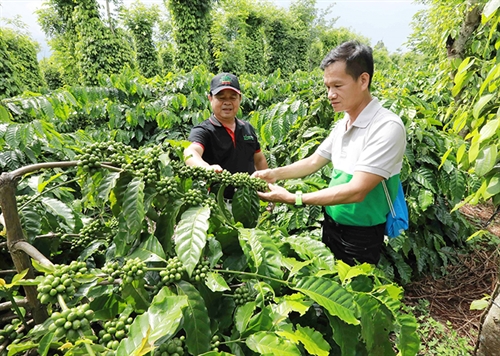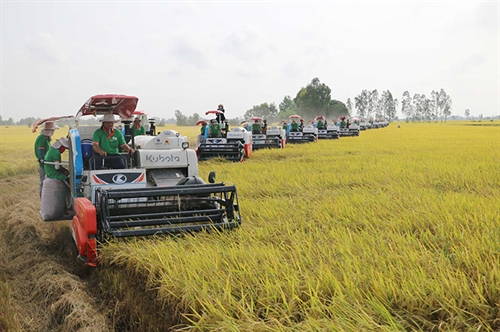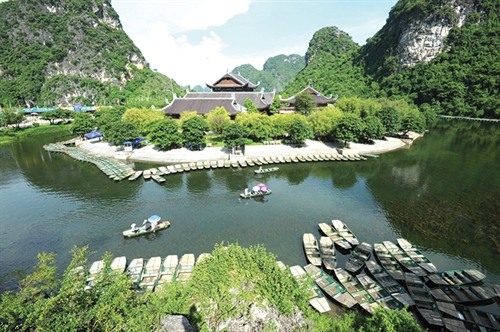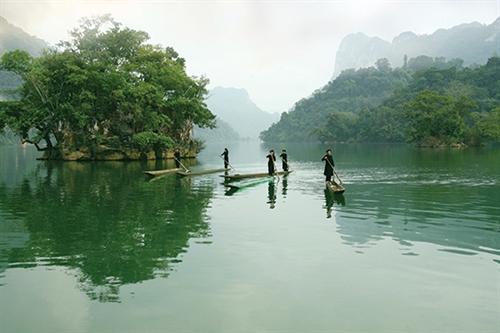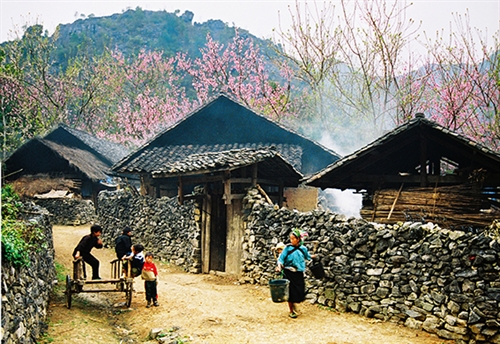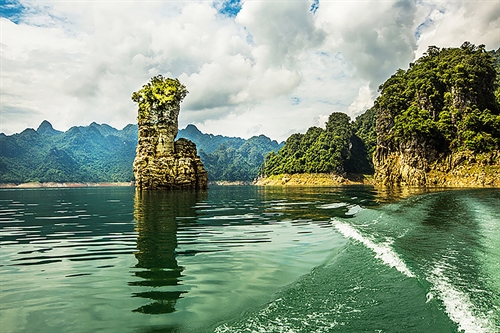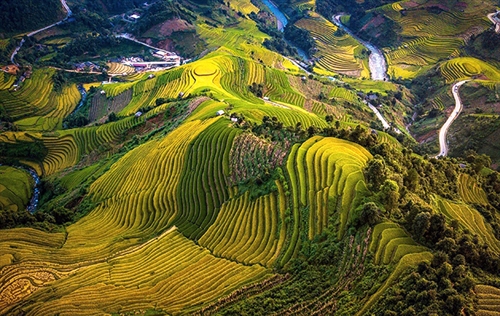“Dak Nong province pledges to create a favorable environment for investors in order to successfully build the province’s three economic pillars: mining industry and renewable energy; hi-tech agriculture, and eco-tourism combined with cultural development,” said Secretary of the Dak Nong Provincial Party Committee Ngo Thanh Danh.
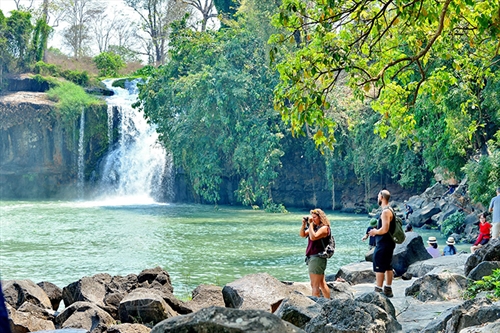 |
| Dray Sap waterfall__Photo: Thanh Hoa/VNA |
Located at the southern gateway of the Central Highlands and sharing a borderline of 141 kilometers with Cambodia, Dak Nong province borders Dak Lak province to the north, Lam Dong province to the east, Binh Phuoc province to the south, and Cambodia’s Mondulkiri province to the west. It is the trade hub linking other central Highlands provinces and the southern key economic region as well as the southern central coast.
Situated at an average altitude of 600-800 meters above sea level, the province has a highland tropical monsoon climate with two distinct seasons - dry and rainy seasons. It boasts a diverse and rich terrain with valleys, high mountains and plateaus.
The province is now only accessible by road. It is linked with other Central Highlands and southern provinces by Highway 14 and with Lam Dong province and southern Central localities by Highway 28. Therefore, the Gia Nghia (Dak Nong)-Chon Thanh (Binh Phuoc) expressway - the western section of the north-south expressway project - connecting Dak Nong with other localities in the Central Highlands and economic hubs in the south is expected to boost its provincial socio-economic development. The Ministry of Transport has recently approved the province’s plan to expand and convert existing Nhan Co airfield into a special-use airport to serve both military and civil purposes. The ministry has also asked the provincial authorities to add the content of possibility of such conversion when all necessary conditions are met and in conformity with the overall master plan on development of the national airport and airfield system.
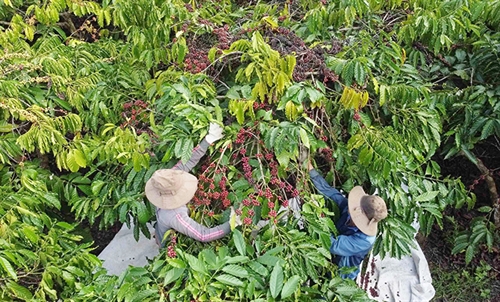 |
| Harvesting coffee__Photo: Vu Sinh/VNA |
Both provincial authorities and local people have exerted their great efforts to considerably improve the province’s business and investment environment. With a score of 61.95 points, the province jumped eight places to 52nd in the 2021 Provincial Competitiveness Index (PCI) ranking with improvements recorded in three sub-indexes: market entry cost (7.34 points), time costs (7.57 points) and law and order (7.68 points). Moreover, it leapt 10 notches to the 41st place out of 63 provinces and cities nationwide in the 2021 Public Administration Reform Index (PAR Index) and ranked 46th in the 2021 Satisfaction Index of Public Administration Services (SIPAS).
The province boasts many high-quality bauxite mines. With an estimated total of 5.4 billion tons, Dak Nong’s bauxite reserves make up 60 percent of the country’s total while the nation ranks third in the world in terms of bauxite reserves. However, in addition to the operating Nhan Co aluminum plant, the USD 800 million Dak Nong aluminum electrolysis plant in Nhan Co industrial park (both are located in Dak R’Lap district) is expected to turn out its first products by 2024. The province hopes to be connected with domestic and foreign investors to develop a bauxite-aluminum-metallurgy industry complex.
Apart from its rich mineral resources, the province has great potential for renewable energy development. In fact, Dak Nong gets between 2,000 and 2,600 hours of sunshine per year and has so far accommodated six under-construction wind power projects, all located in Dak Song district, with a combined output of 430 MW.
The province also has around 366,000 hectares of agricultural land with fertile basalt soil layers ideal for perennial industrial crops, such as coffee, rubber, pepper and fruit trees, and black and alluvial soil, for food crops and beans. It plans to maintain its acreage of coffee, pepper, rubber and cashew but still expands the areas under macadamia and high-valued fruit trees. In addition, the province plans to form hi-tech agriculture zones for specialty products. Therefore, it is seeking investment in farm produce semi-processing and processing plants combined with material zones.
At present, the province houses 12 foreign direct investment (FDI) projects that are worth a total of USD 676.6 million and specialized in farm produce processing, warehouse building, timber production, and wind-powered electricity generation. With three projects capitalized at USD 457.6 million, Singapore is leading the total of seven countries and territories investing in the province, director of the Dak Nong Planning and Investment Department Tran Dinh Ninh told the Vietnam Law & Legal Forum magazine.
Ninh said Dak Nong province is formulating a resolution on investment incentive and support policies. As per this resolution, investors would be provided with free-of-charge information on investment environment, planning and land fund. They would receive support in completing administrative procedures for implementation of their investment projects since the commencement of project construction until project operation. Investors would enjoy legal assistance in solving problems arising in the course of operation. They would also be exempted from half of charges for participation in exhibitions and fairs organized by Dak Nong in the country and abroad.
Tourism is another sector of the province’s three-pillar economy. This year, the sector is expected to receive 615,000 tourist arrivals (including 3,000 foreign tourist arrivals) and earn a turnover of VND 78.8 billion (USD 3.28 million).
According to director Le Ngoc Quang of the Dak Nong Department of Culture, Sports and Tourism, the sector will regularly post tourism advertisements on “Dak Nong tourism information” Facebook fanpage; and websites of the Dak Nong Department of Culture, Sports and Tourism and the Dak Nong People’s Committee.
In addition, it will help local travel agents to diversify and improve the quality of tourism services. The province will work with the provincial Department of Science and Technology to finalize the “Dak Nong e-tourism map” and “Information technology application serving Dak Nong smart tourism during the 2022-2025 period” schemes so as to intensify the application of digital technology in the hospitality sector.
The sector has so far concluded cooperation agreements on socio-economic development, including tourism, with Ho Chi Minh City, Binh Phuoc province, other Central Highlands provinces and Cambodia’s Mondulkiri province.-
| Provincial facts Land area: 6,513 sq. km Administrative units: Gia Nghia city and the districts of Dak G’long, Cu Jut, Dak Mil, Krong No, Dak Song, Dak R’lap and Tuy Duc Population: around 700,000 (the latest statistics) Ethnic groups: 40 ethnic groups with the Kinh (Viet) being the most populous, followed by the Ma, Ede and M’nong Socio-economic figures - Export turnover: some USD 1.1 billion - Main exports: coffee, black pepper, cashew nuts, macadamia, jackfruit and durian - Gross regional domestic product (GRDP): VND 22.4 trillion (USD 933 million) in 2022 with a year-on-year increase of 7.6 percent - Industrial parks (IPs): Tam Thang IP on 179.2 hectares in Cu Jut district and Nhan Co IP on 148 hectares in Dak R’lap district, and a hi-tech agricultural park on 120.42 hectares in Gia Nghia city - Farm products bearing geographical indications: Dak Nong pepper Tourism - Famous tourist attractions: + Dak Nong UNESCO global geopark + Wonderful waterfalls, including Dray Sap waterfall, Gia Long waterfall, Lua waterfall, Luu Ly waterfall, and 7-tiered waterfall + Ta Dung national park + Exhibition hall of ancient musical instruments + Exhibition hall of gongs + Nam Kar volcano range + Truc Lam Dao Nguyen zen monastery + Nam Nung - a legendary revolutionary base + Dak R’Mang market + Buor village - ancient village of Ede ethnic group + Yen Ngoc natural and eco-tourism farm + Phuoc Son agro-ecological tourism area + Dak G’Lun waterfall eco-tourism area - Craft villages: M’nong traditional bamboo and rattan weaving village - Travelers: 512,500 (including 2,000 foreign holiday makers) in 2022 and some 190,600 (including 650 foreign holiday makers) in the first two months of 2023 - Tourist accommodations: 306 hotels, guest houses and homestays - Festivals: + Community union festival of M’nong ethnic group + Tam Blang M’Prang Bon festival (tree planting festival) of M’nong Preh, a sub-group of the M’nong + Gong culture festival, which is held annually in rotation in Dak Nong and four other Central Highlands provinces of Lam Dong, Kon Tum, Dak Lak and Gia Lai (Source: https://daknong.gov.vn, https://bdt.daknong.gov.vn, https://baodaknong.vn, https://stttt.daknong.gov.vn/, https://bqlkcn.daknong.gov.vn |


